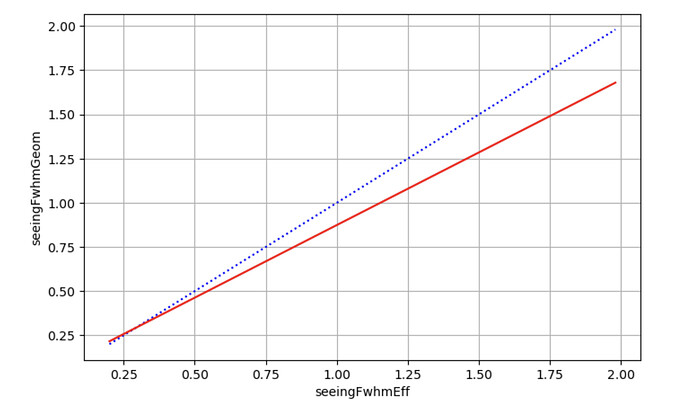In the scheduler simulation documentation it’s stated that seeingFwhmEff should be used to calculate SNR for point sources, but we’ve received advice in the past to use seeingFwhmGeom, but we’re unclear on why. Is there a more in depth description of the difference between the two and which one we should use?
Is the “advice in the past to use seeingFwhmGeom” related to using opsim outputs to calculate things like trailing losses?
The difference between seeingFwhmEff and seeingFwhmGeom is related to what and how you’re measuring a quantity about the PSF. If you had a simple Gaussian PSF, then these two would be identical - the seeingFwhmEff would be the PSF of the Gaussian that results in the proper SNR if you calculate SNR using standard gaussian PSF formula (which is the “usual way”), and the seeingFwhmGeom would be the FWHM of the stellar profile in the image (a ‘geometric’ kind of measurement, of “size”).
However, Rubin (and actually most if not all ground-based telescopes) does not actually produce a single Gaussian PSF. It doesn’t even produce a double-Gaussian PSF, which is a slightly more complicated but still easily understood profile. The PSF is instead a von Karman profile, and as a result these two values are NOT the same.
The seeingFwhmGeom is the FWHM of the measured PSF, so related to the “size” of the PSF. For metrics which involve “how well can I measure the position of something” (or the width of something on the CCD, such as trailing losses for moving objects), it is usually more reasonable to use the seeingFwhmGeom.
The seeingFwhmEff is the FWHM of the single Gaussian PSF which would produce the equivalent SNR for a stellar source. Thus it’s related to SNR calculations and should be used if you’re calculating SNR assuming a gaussian PSF, but it’s not actually the “size” of the PSF.
Generally, the fwhm_eff is slightly larger than the fwhm_geom.
This relationship between fwhm_geom and fwhm_eff was established by Bo Xin and Zeljko Ivezic through simulations of the LSST focal plane, and verified through measurements from SDSS.
See more background in A Study of the Point-spread Function in SDSS Images - IOPscience
Hi @samncorn! I just wanted to check in and see whether this answered your question, or if there’s further information that may help us resolve it? Thanks!
